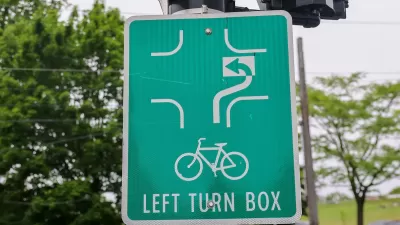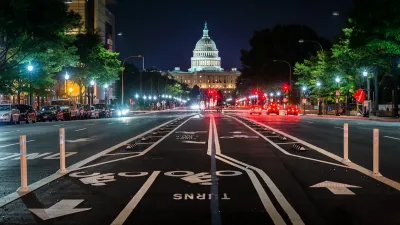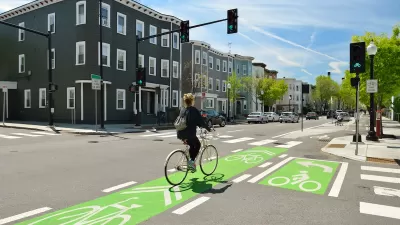After 11 years, the federal transportation manual is getting an update to reflect the rise of autonomous vehicles, shared mobility, and modernized pedestrian infrastructure.

The Federal Highway Administration has extended the public comment period for its update of the Manual of Uniform Traffic Control Devices (MUTCD). The manual, which hasn't been updated since 2009, "sets federal standards for the signs, markings and signals that help instruct road users on how to safely move through our communities."
As reported by Kea Wilson in Streetsblog, advocates hope that the revised manual will take into account new programs and mobility options such as bike share, scooters, and autonomous cars and implement higher standards for protecting vulnerable users. Rather than prioritize vehicle throughput above safety, planner Don Kostelec told Streetsblog, the manual should include the highest standards for safety at crosswalks and other vulnerable interaction points.
The main reason for the manual's upcoming revision seems to be the rise of autonomous vehicles, "which rely on regular road markings to navigate complex road environments," but some of these changes may work in favor of bike advocates. For example, the revised manual calls for bike facilities to be "segregated from other vehicle traffic using physical barriers where practicable and that road markings are needed to denote the end of a bike lane that is merged with traffic" in order to accommodate "machine vision." Such policy changes in manuals like the MUTCD, argues BikeUtah program director Mike Wiltsie, is "the best way we can bring about systemic change in our streets."
FULL STORY: Memo to Buttigieg: Fix Our National Traffic Control Standards

Alabama: Trump Terminates Settlements for Black Communities Harmed By Raw Sewage
Trump deemed the landmark civil rights agreement “illegal DEI and environmental justice policy.”

Planetizen Federal Action Tracker
A weekly monitor of how Trump’s orders and actions are impacting planners and planning in America.

The 120 Year Old Tiny Home Villages That Sheltered San Francisco’s Earthquake Refugees
More than a century ago, San Francisco mobilized to house thousands of residents displaced by the 1906 earthquake. Could their strategy offer a model for the present?

In Both Crashes and Crime, Public Transportation is Far Safer than Driving
Contrary to popular assumptions, public transportation has far lower crash and crime rates than automobile travel. For safer communities, improve and encourage transit travel.

Report: Zoning Reforms Should Complement Nashville’s Ambitious Transit Plan
Without reform, restrictive zoning codes will limit the impact of the city’s planned transit expansion and could exclude some of the residents who depend on transit the most.

Judge Orders Release of Frozen IRA, IIJA Funding
The decision is a victory for environmental groups who charged that freezing funds for critical infrastructure and disaster response programs caused “real and irreparable harm” to communities.
Urban Design for Planners 1: Software Tools
This six-course series explores essential urban design concepts using open source software and equips planners with the tools they need to participate fully in the urban design process.
Planning for Universal Design
Learn the tools for implementing Universal Design in planning regulations.
Clanton & Associates, Inc.
Jessamine County Fiscal Court
Institute for Housing and Urban Development Studies (IHS)
City of Grandview
Harvard GSD Executive Education
Toledo-Lucas County Plan Commissions
Salt Lake City
NYU Wagner Graduate School of Public Service





























